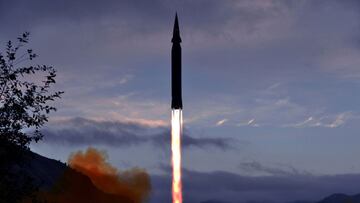What are the Israeli missile shields like that stopped the Iranian drone attack?
The shields have three layers: one to intercept long-range missiles, another for medium-range threats, and the last one called the Iron Dome.

On Saturday night more than 300 drones and missiles traveled hundreds of miles from Iran to Israel. However, according to Netanyahu’s Defense Forces 99% of the threats were shot down thanks to anti-aircraft systems and the help of fighters from the United States, the United Kingdom and Jordan.
The attack occurred after weeks of tension in the Middle East between Iran and Israel. The Iranian Revolutionary Guard justified its attack as a response to the bombing of the consulate in Damascus on April 1, in which seven members of the Revolutionary Guard lost their lives. Iran’s leader has warned after the attack that “the next response will be considerably more severe.”
READ ALSO: Who are Iran’s allies?
Meanwhile, US Secretary of Defense Lloyd Austin has explained in a statement that “U.S. forces in the Middle East on April 13 intercepted dozens of missiles and UAVs en route to Israel, launched from Iran, Iraq, Syria and Yemen. Our forces remain postured to protect U.S. troops and partners in the region, provide further support for Israel’s defense, and enhance regional stability.”
The death toll has remained at zero thanks to the fact that anti-aircraft systems managed to shoot down a large part of the projectiles before they could cause further damage. The Israeli army stated that 40 launches were identified from Lebanese territory, some of which were intercepted, while the rest fell in open areas.
The missile shields with which Israel stopped the Iranian drone attack
Israel’s main defense consists of three layers of anti-missile shields, specially designed for different types of air threats. The first focuses on long-range missiles, the second on medium-range threats, and the last focuses on defending smaller areas on the surface, but with greater intensity of attacks.
Long Range: Arrow and David's Sling
These are responsible for protecting the country from long-range attacks, such as ballistic and hypersonic missiles. The newest version of the Arrow system is the Arrow 3, an exoatmospheric anti-ballistic missile system developed by Israel and the United States.
Its first successful flight was in 2013 and the first interception took place in November 2023 against a ballistic missile launched by the Houthis in Yemen. This system has a range of 2,400 kilometers and a maximum altitude of 100 kilometers. It has several elements in addition to the interceptor missile itself, the most notable of which is the radar array placed throughout the territory and that searches for large ballistic threats from the sky.
Once the missile is detected, the control center gives the order to launch the Arrow 3 designed to intercept and destroy the newest and longest-ranged threats, especially those carrying weapons of mass destruction.
Meanwhile, David’s Sling is the other system in charge of long-range threats. It was developed by Israel and is defined by its maker, Israeli defense technology company Rafael, as a “modular, scalable and flexible system.” It began development in 2006, but only officially entered the Defense Forces in 2017. The intention was for it to be one step below the Arrow.
On May 10, 2023, it made its first interception after stopping a rocket launched from Gaza against civilians in Israel. Its operating range is between 40 and 300 kilometers and it can exceed 8,000 kilometers in speed. When interception is required, the planned course is communicated to the launcher through a dedicated data link and the missile can be reoriented in real time to successfully eliminate the threat.
Spyder mobile air defense system

Developed by Rafael, it is considered to be at a lower level than the previous systems. According to its website, this mobile air defense system “defends large areas, as well as maneuver forces, against a wide spectrum of threats, such as attack aircraft, helicopters, bombers, cruise missiles, unmanned aerial vehicles and combat weapons.”
The first time it managed to stop an attack was in 2005 using two types of missiles: Derby and Pynthon 5.
The first is a medium-range interceptor guided by active radar designed to perform aerial missions, although it can also perform a ground-to-air role. It has a radar and an infrared seeker located in its nose. Its dimensions are 3.5 meters long by 16 meters in diameter and its propeller allows it a range of up to 50 kilometers in its air-to-air version, somewhat less than from the ground.
Phyton 5 is the most modern platform and achieves coverage in a radius of just over 20 kilometers. “Spyder systems defend large areas against a wide spectrum of threats,” says Rafael, which also explains that “the system components and interceptors can be combined flexibly, offering different configurations with diverse ranks and capabilities.”
READ ALSO: Iran dwarfs Israel in some metrics
Iron Dome
This anti-missile shield also developed by Rafael has been operational since 2011. It is the “most deployed missile defense system in the world, with more than 2,000 interceptions and a success rate of over 90%,” according to the same company. Its distinctive feature is that it is capable of detecting potential threats at great distances.
“The threat trajectory is quickly analyzed and an impact point is estimated. If this estimated trajectory translates into a critical threat, a command is executed and an interceptor rocket is launched against the threat,” explains Rafael.
The process from when the threat is located until it is intercepted lasts about 15 seconds, which can sometimes be too long a period if the projectiles are launched from very close range.
Finally, there are the Tamir missiles, also of Israeli origin, which have all types of electro-optical sensors and can also be guided thanks to some movable ailerons that they have. They measure three meters in length and 15 centimeters in diameter, while their mass is 90 kilograms.





